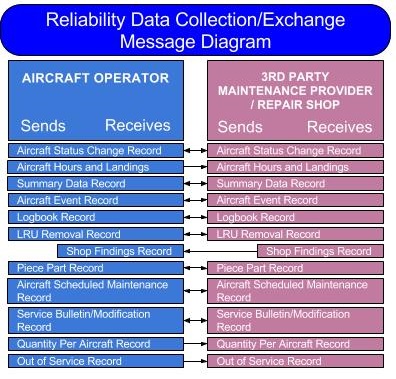Reliability data is collected widely by every aircraft operator, airframe, engine and component manufacturer in the world. The data is collected daily and analysed in an effort to further enhance aircraft reliability.
The SPEC2000 Chapter 11 provides a set of standardised message structures for this purpose.
Utilising Blue Flag Technologies' SPEC2000 Chapter 11 / Reliability module across ARINC, SITA or Internet networks, standard Reliability Data can be sent to and received from your trading partners quickly and easily.
Due to a variety of collection methods which are unique to individual companies, any attempt to exchange data or measure reliability across the industry is time-consuming, costly and subject to error. The development and implementation of standard formats for collecting and exchanging aircraft and component reliability data enables the industry to collect, measure and exchange this information in a consistent format – ultimately improving efficiency and reducing both costs and errors.
Additionally, in recent years, companies have begun to develop reliability databases in which key partner information can be stored and analyzed. The standard formats provided in Chapter 11 facilitate this process.
There are many reasons for collecting/exchanging and analyzing reliability data.
One reason is for understanding in-service airplane, engine and component reliability performance and to quickly identify problems so that root cause analyses can be performed for problem identification and resolution. This type of analysis may uncover an operator’s training, logistics and/or operations problems being the cause of an apparent reliability issue as well as being caused by the aircraft, its systems, engines or components.
In-service reliability data is often used by manufacturers to compare design-phase, service/repair/overhaul/life predictions to the in-service actuals to assess the accuracy and validity of the analyses performed during design.
Other uses of in-service reliability data:
- Assist operators and manufacturers to attain higher reliability through trend monitoring.
- Determine if certain problem areas are unique to an operator or if others are experiencing the same problems.
- Determine if the Mean Time Between Unscheduled Removals or No Fault Found Rate one operator is experiencing is better or worse than the industry norm.
- Determine which modification has a better payback by comparing removal and failure rates of operators incorporating various Service Bulletins or Modifications.
- Calculate schedule interruption rates.
- Document aircraft flight hours, flight lengths, number of landing cycles as well as utilization rates.
- Understand shop findings to determine if a removal confirms the reason for removal.
- Calculate failure mode rates.
- Assist operators and manufacturers in determining the effectiveness of aircraft maintenance programs.
- Fulfill regulatory requirements for reporting and analyses.
The standardised Reliability messages are as follows:
- Aircraft Status Change Record - for collecting and exchanging aircraft changes in ownership, registration number and engine type. This message can also be used to report aircraft long term out-of-service. Sent by aircraft receiving organisation and the aircraft releasing organisation. Engine type changes are reported by the aircraft operator.
- Aircraft Hours and Landings Record - for detailing the total and monthly flight hours and cycles of an operators fleet. This message can also be used to report aircraft short term out-of-service. Sent by aircraft operator.
- Summary Data Record - for collecting summarised rate and count information on an operator's fleet. Sent by the aircraft operator or third party maintenance provider.
- Aircraft Event Record - for collecting aircraft technical incidents as well as delay, cancellation, air or ground turnbacks and aircraft diversions data. It is to be completed by an aircraft operator or third party maintenance provider.
- Logbook Record - for collecting aircraft Technical Logbook, Maintenance Logbook and Cabin Logbook data. Sent by the aircraft operator or third party maintenance provider.
- LRU Removal Record (also known as Component Removal Record) - for collecting LRU removal data identified by part number, serial number, Commercial And Government Entity (CAGE) code as well as the aircraft from which it was removed and the details surrounding why the LRU needed to be removed. Sent by the aircraft operator, third party repair facility or whoever is removing the component.
- Shop Findings Record - for collecting and exchanging LRU shop repair/teardown findings. Sent by an aircraft operator’s repair shop, third party repair facility or original equipment manufacturer for the purpose of detailing the findings associated with an LRU that enters a shop. The Shop Findings Record is also used to collect Shop Replaceable Units (SRU’s) and other piece parts associated with the shop received LRU
- Piece Part Record - for collecting and exchanging information about Shop Replaceable Units (SRU’s) and other piece parts associated with a shop received LRU.
- Aircraft Scheduled Maintenance Record - for collecting aircraft scheduled maintenance visit data. Sent by an aircraft operator or a third party maintenance provider.
- Service Bulletin/Modification Record - for collecting information on the incorporation of service bulletins, other modifications such as Supplemental Type Certificates and Airworthiness Directives when included with a Service Bulletin. Airworthiness Directives not accompanied by a Service Bulletin will only be collected in the Logbook record. Sent by the aircraft operator or the third party maintenance provider that incorporated the bulletins.
- Quantity Per Aircraft Record - for collecting quantity per aircraft of key components either by aircraft or by fleet. Sent by the aircraft operator. The primary purpose of this information is to quantify reliability performance metrics used in Spec 2000 Chapter 13. It becomes the source of the QPA value used in the calculations of MTBUR, MTBF, etc.
- Out of Service Record - for collecting information on Out of Service Aircraft. This includes both scheduled and unscheduled out of service conditions. This record is used in conjunction with other operational records such as Aircraft Hours and Landings Record to calculate aircraft availability metrics. Note that long term out of service (i.e. where an aircraft is not expected to return to service as of current conditions) are reported in the Aircraft Status Change Record.

